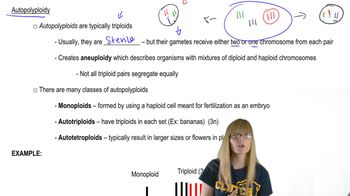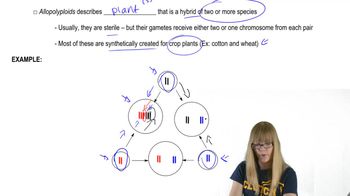Table of contents
- 1. Introduction to Genetics51m
- 2. Mendel's Laws of Inheritance3h 37m
- 3. Extensions to Mendelian Inheritance2h 41m
- 4. Genetic Mapping and Linkage2h 28m
- 5. Genetics of Bacteria and Viruses1h 21m
- 6. Chromosomal Variation1h 48m
- 7. DNA and Chromosome Structure56m
- 8. DNA Replication1h 10m
- 9. Mitosis and Meiosis1h 34m
- 10. Transcription1h 0m
- 11. Translation58m
- 12. Gene Regulation in Prokaryotes1h 19m
- 13. Gene Regulation in Eukaryotes44m
- 14. Genetic Control of Development44m
- 15. Genomes and Genomics1h 50m
- 16. Transposable Elements47m
- 17. Mutation, Repair, and Recombination1h 6m
- 18. Molecular Genetic Tools19m
- 19. Cancer Genetics29m
- 20. Quantitative Genetics1h 26m
- 21. Population Genetics50m
- 22. Evolutionary Genetics29m
6. Chromosomal Variation
Chromosomal Mutations: Aberrant Euploidy
Problem 7a
Textbook Question
Textbook QuestionFrom the following list, identify the types of chromosome changes you expect to show phenotypic consequences.
polyploidy
 Verified Solution
Verified SolutionThis video solution was recommended by our tutors as helpful for the problem above
Video duration:
1mPlay a video:
Was this helpful?
Key Concepts
Here are the essential concepts you must grasp in order to answer the question correctly.
Polyploidy
Polyploidy refers to the condition in which an organism has more than two complete sets of chromosomes. This can occur naturally, as seen in many plants, or can be induced artificially. Polyploidy can lead to significant phenotypic changes, such as increased size or altered metabolic pathways, due to the presence of additional genetic material.
Recommended video:
Guided course

Autopolyploidy
Chromosomal Aberrations
Chromosomal aberrations are structural changes in chromosomes that can result from errors during cell division or environmental factors. These changes can include deletions, duplications, inversions, and translocations, which may disrupt gene function and lead to observable phenotypic effects, such as developmental disorders or cancer.
Recommended video:
Guided course

Aberrant Euploid
Phenotypic Consequences
Phenotypic consequences refer to the observable traits or characteristics of an organism that result from its genetic makeup and environmental interactions. Changes in chromosome number or structure, such as those caused by polyploidy or chromosomal aberrations, can lead to variations in phenotype, affecting traits like growth, reproduction, and resistance to diseases.
Recommended video:
Guided course

Mutations and Phenotypes

 8:42m
8:42mWatch next
Master Aberrant Euploid with a bite sized video explanation from Kylia Goodner
Start learning

